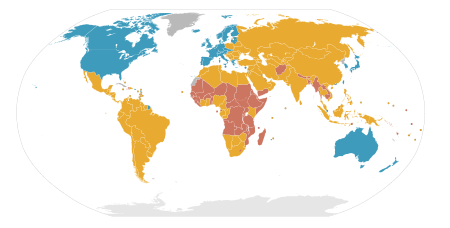Developed country facts for kids

This map shows how the IMF and UN classify countries.
A developed country (also called an industrialised country or more economically developed country (MEDC)) is a nation that has a strong economy and lots of modern things. This includes good infrastructure like roads, airports, and reliable electricity. These countries usually have more businesses and industries compared to a developing country.
To measure how developed a country is, people often look at its gross domestic product (GDP). This is the total value of all goods and services made in a country in a year. Another important measure is per capita income, which is the average amount of money each person in the country earns. Other things that show a country is developed include how much industry it has, how much infrastructure is built, how many people can read and write, how long people usually live (their life expectancy), and their general standard of living. There isn't one exact rule to decide if a country is developed or developing, so people sometimes disagree.
Developed countries often have what's called a post-industrial economy. This means that jobs in the service sector are more important than jobs in the industrial sector. Service jobs involve doing something for others, like selling products, fixing things, or working in healthcare. Industrial jobs are about making products, usually in factories. In developed countries, some factory jobs might be moved (this is called outsourcing) to less developed countries where workers are paid less. Developing nations might be busy building their factories and infrastructure. Countries that are less developed often rely heavily on agriculture, sometimes just growing enough food for themselves (called subsistence farming).
The first country to become industrialised was the UK, followed by Belgium. Later, countries like Germany, the US, France, and other Western European nations also industrialised. Many experts believe that the big difference between developed and developing countries mostly happened in the 20th century.
Contents
How Developed Countries Influence the World
Developed countries have a big impact on the global economy. For example, the International Monetary Fund reported that developed countries produced over half of the world's total economic output in 2010.
A group of major developed economies includes the US, Japan, Germany, France, the UK, Italy, and Canada. These countries are often called the G7. Even though the G7 countries have only about 10% of the world's population, they create almost 40% of the world's total economic output. They also play a large role in making important economic decisions that affect the whole world. Four of the five permanent members of the United Nations Security Council are also part of the G8 (which is the G7 plus Russia).
Other Names for Developed Countries
You might hear other terms that mean similar things to developed country. These include:
- advanced country
- industrialised country
- more developed country (MDC)
- more economically developed country (MEDC) (which is compared to a less economically developed country (LEDC))
- Global North country
- first-world country
- post-industrial country
Different Ways to Measure Development
Economic measures, like the average money each person earns (income per capita), are usually seen as the most important way to tell if a country is developed. Countries with a high GDP per capita and a lot of industry are often called developed. However, some people believe that just having a modern economy isn't the only way to measure how much a country has progressed.
More recently, another important measure called the Human Development Index (HDI) has become popular. The HDI looks at more than just money. It combines information about jobs and income with how much access people have to medicine, how long they live, and how much education they receive. The UN HDI helps measure a country's overall human development. While countries with a high HDI score usually have a strong economy, it's not always the case. For instance, in 2010, the top 47 countries by HDI had scores ranging from 0.793 in Barbados to 0.955 in Norway. Many countries with an HDI of 0.788 or higher (as of 2010) are also listed as "advanced" by groups like the IMF or CIA (as of 2009).
The country of Bhutan came up with an interesting idea called Gross National Happiness (GNH). This measure tries to figure out how happy people in a country actually are. Bhutan believed that GNH was just as important as GDP, and this idea has started to spread to other countries too.
Images for kids
-
Countries by 2018 GDP (nominal) per capita
See also
 In Spanish: País desarrollado para niños
In Spanish: País desarrollado para niños




